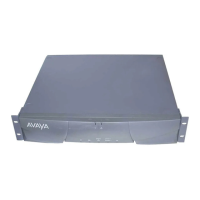Alarms, Errors, and Troubleshooting
555-233-143
4-12 Issue 1 May 2002
Figure 4-2. Determining the Cause of a Server Interchange
Use the SYSTEM error table following this
chart to determine which SPE component
is implicated.
This indicates a serious processor/memory
bus problem. Busyout or, preferably, lock
the standby SPE to prevent an
interchange, and escalate the problem.
Consult MO documentation for PKT-INT.
Is there a Major alarm against
the standby SW-CTL?
no
no
no
no
no
no
no
no
Consult MO documentation for TAPE.
Consult the MO documentation for the
indicated component.
yes
yes
yes
yes
Replace the standby
MSSNET circuit pack.
yes
yes
Consult CARR-POW in
Chapter 9.
yes
yes
If handshake is down (check status spe),
replace the alarmed standby circuit pack
If handshake is up, execute a
test long clear of the alarmed
component and consult documentation
for that MO in Chapter 9.
Proceed to the next flowchart, Testing
the Standby SPE
Is there a TAPE error 3585 with aux code 408?
Is there a PKT-INT error 100?
Is there an error 150 against any SPE component?
Is there a SYSTEM error 6002, 6003,
6102, or 6103?
Enter display errors and look for unalarmed
errors for SPE components, CARR-POW
and SYSTEM. Is there a SYSTEM
error 6001 or 6101.
Enter display alarms for categories SPE
and environ. Are there any major
alarms against CARR-POW?
Are there major alarms against other
SPE components?
All relevant alarms must be timestamped at or near the time of interchange.

